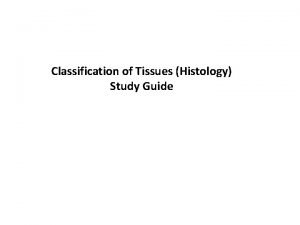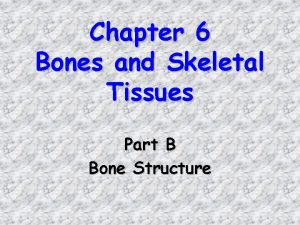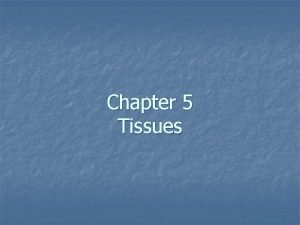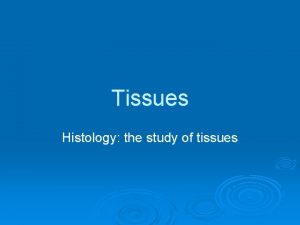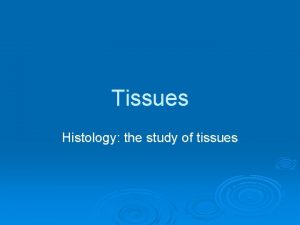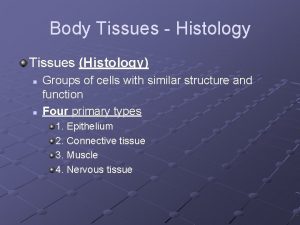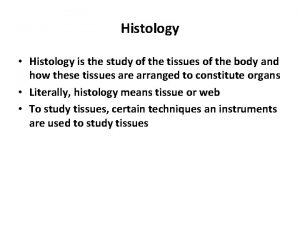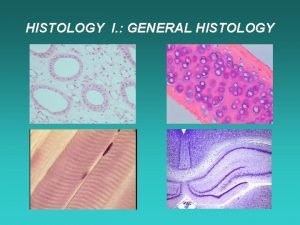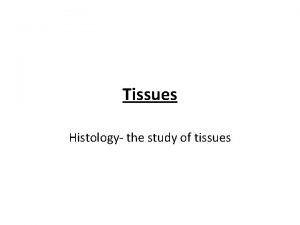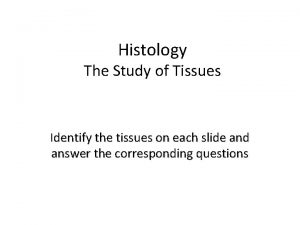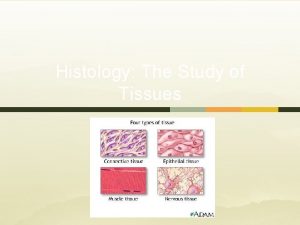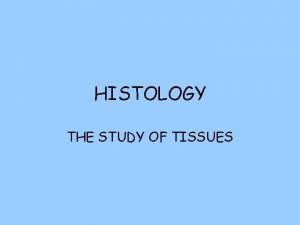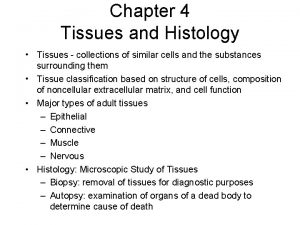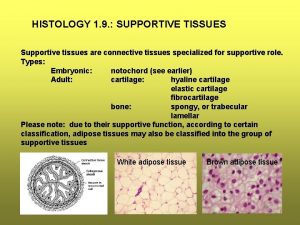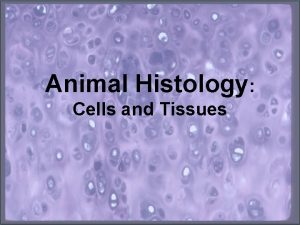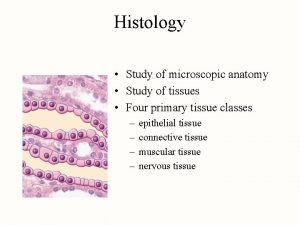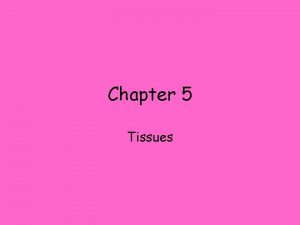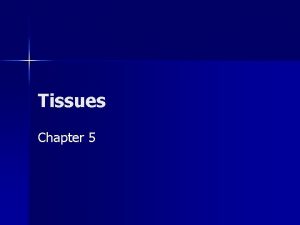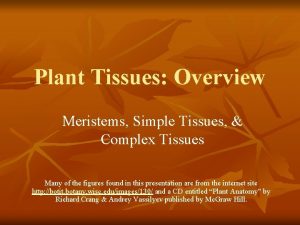Tissues Chapter 4 Tissues Histology The study of












































- Slides: 44

Tissues Chapter 4

Tissues Histology - The study of tissues Tissues are groups of cells and extracellular material that perform specific functions. n The four tissue types, in varying combinations, form all of the structures (organs) of the human body. n

Four Basic Tissue Types: § Epithelial § Connective § Muscular (muscle) § Neural (nervous)

Epithelial Tissue (epithelium) n General Characteristics Epithelial cells closely packed & attached to each other by a variety of intercellular connections ¨ Cells exposed to external environment or internal surface at _______ region ¨ _____ surface in close proximity or attached to underlying connective tissue at basement membrane ¨ Avascular ¨ Regenerates easily ¨

Epithelial Tissue Subtypes of epithelial tissue Glandular - secretory structures derived from epithelia Endocrine glands - Exocrine glands - Surface (Covering & lining) epithelium - an avascular sheet of cells that lines internal or external surfaces & covers organs within cavities; - always attached to connective tissue (CT) creating an “____”

Epithelial Membranes Combination of epithelial tissue attached to connective tissue ¨ Connection of tissues occurs at the basement membrane ¨ ¨ Basement membrane creates a semipermeable junction

Types of Epithelial membranes Mucous membranes (mucosa) ¨ Serous membranes (serosa) ¨ Cutaneous membrane (skin) ¨

Mucous membranes (mucosa) q Location: q Epithelial cells secrete: q Examples:

Serous membranes (serosa) ¨ Location: ¨ Always have two layers – Parietal layer – n Visceral layer – n ¨ Epithelial cells secrete: ¨ Examples:

Serous Membranes Pleura § parietal pleura – lines thoracic cavity § visceral pleura – covers surface of lungs Pericardium § parietal pericardium – lines pericardial sac § visceral pericardium – covers surface of heart Peritoneum § parietal peritoneum- lines abdominal cavity wall § visceral peritoneum- covers most organs within the cavity

Cutaneous membrane (a. k. a. skin) q Location: q Epithelial layer is called _____ q Connective layer is called _____

Classifying covering & lining Epithelia: q Number of layers n Simple – n Stratified – n Pseudostratified – q Cell shape § Squamous § Cuboidal § Columnar -

Epithelial cells (columnar or cuboidal) may be modified with: § microvilli § cilia Figure 4 -3

Epithelial Tissues Pseudostratified columnar epithelium (ciliated)

Epithelial Tissue n Simple Squamous Epithelium LOCATIONS: Epithelia lining ventral body cavities; lining heart and blood vessels; portions of kidney nephron; (inner lining of cornea; alveoli (air sacs) of lungs FUNCTIONS: Reduces friction; controls vessel permeability; performs absorption and secretion

Epithelial Tissue n Simple columnar epithelium LOCATIONS: Lining of stomach, intestine, gallbladder, uterine tubes (ciliated), and collecting ducts of kidneys FUNCTIONS: Protection, secretion, absorption

Epithelial Tissue n Stratified Squamous Epithelium LOCATIONS: Surface of Skin (keratinized); lining of mouth, throat, esophagus, rectum, anus, and vagina FUNCTIONS: Provides physical protection against abrasion, pathogens, and chemical attack 2 types: Keratinized Non-keratinized

Epithelial Tissue n Pseudostratified Ciliated Columnar LOCATIONS: Lining of nasal cavity, trachea, and bronchi; portions of male reproductive tract FUNCTIONS: Protection, secretion, move mucus with cilia )

Connective Tissue (CT) n General Characteristics: ¨ Cells differ depending on specific type of CT (e. g. mesenchymal, fibroblasts, chondrocytes, osteocytes) ¨ Cells usually widely spaced with intercellular matrix between ¨ Usually well vascularized (exception: cartilage) ¨ Usually do not regenerate easily ¨ Repair ability varies depending on type of CT

Connective Tissues n Components of Connective Tissues: Specialized cells ¨ Extracellular matrix ¨ n Ground substance n Protein fibers Collagen ¨ Elastic ¨ Reticular ¨

Whereas in epithelial tissue, the cell shape, layers and cell modifications were important to determine the function of the tissue, in connective tissues, the matrix of the tissue most directly determines the functional qualities of the tissue.

Classification of Connective Tissues Embryonic CT - Mesenchyme ¨ Connective tissue proper ¨ n n ¨ __________ Supporting connective tissues ___________ n ¨ Fluid connective tissues Blood n Lymph n

Connective Tissues Major Types of Connective Tissue MESENCHYME CONNECTIVE TISSUES CONNECTIVE TISSUE PROPER LOOSE Fibers create loose, open framework DENSE Fibers densely packed FLUID CONNECTIVE TISSUES BLOOD Flows within cardiovascular system LYMPH Flows within lymphatic system SUPPORTING CONNECTIVE TISSUES CARTILAGE BONE Solid, rubbery matrix Solid, crystalline matrix

Mesenchyme § § § Only found in the developing embryo Mesenchymal cells in a thick fluid ground substance Mesenchyme is the precursor to all other forms of CT

Connective Tissue “Proper” Most common type of cell present is the _____, but these CT’s may also contain adipocytes, macrophages, mast cells & white blood cells. The cells are surrounded by a slippery, syrupy ground substance Fibers vary & may be arranged loosely or densely packed together.

Connective Tissue Proper Depending on the arrangement of fibers, CT proper can be classified into: Loose CTs n Areolar n Adipose Dense CTs § Dense regular (collagenous) § Dense irregular

Connective Tissue Proper n Areolar Connective Tissue

Connective Tissue Proper n Adipose Connective Tissue

Connective Tissue Proper n Dense Regular Connective Tissue

Connective Tissue Proper § Dense Irregular Connective Tissue

Supporting Connective Tissues Cartilage n _____ in lacunae of interstitial fluid within a firm gel-like ground substance n Avascular n Covered by a fibrous perichondrium made of dense irregular CT n Three types of cartilage ¨ Hyaline cartilage ¨ Elastic cartilage ¨ Fibrocartilage

n Hyaline Cartilage

n Elastic Cartilage

n Fibrocartilage

Supportive Connective Tissues Bone (Osseous) Tissue ____ in lacunae of interstitial fluid within a calcified matrix ¨ Matrix comprised of osteoid (mainly collagen) & calcium salts (mainly Ca 3 (PO 4)2 ) ¨ Because of the density of the matrix, osteocytes communicate & receive O 2 / nutrients across canaliculi ¨ Osseous tissue covered by periosteum ¨ Well vascularized tissue ¨

Osseous (Bone) Tissue Bone tissue classified on the basis of the pattern (functional unit) of the matrix Two types of bone tissue § Spongy (cancellous) § Dense (compact)

Osseous Tissue (see chap. 6 for details) Spongy (cancellous) bone tissue: § Matrix (containing osteocytes within lacunae) arranged in trabeculae pattern surrounding marrow spaces § Marrow spaces of spongy bone contain red bone marrow Fig. 6 -3

Osseous (Bone) Tissue (see chap. 6 for details) Compact (cortical, dense) bone tissue: § Matrix forms osteons (Haversian systems) § Osteons comprised of concentric lamellae (layers of matrix sandwiching osteocytes in lacunae) surrounding a central (Haversian) canal, which contains BVs § Osteocytes interconnected by canaliculi which radiate out across lamellae § BVs of central canals interconnect across perforating (Volkmann’s) canals

Fluid (liquid) Connective Tissues Cells + a liquid ground substance n Blood Red blood cells (RBCs), white blood cells (WBCs), platelets + plasma n Lymphocytes (WBCs) + lymph fluid

Tissue Injuries and Repair n n Many different types of injuries can affect tissues – physical (e. g. cuts, bruises), thermal (e. g. burns), chemical, infections An injury usually harms multiple tissues simultaneously Tissues make coordinated response to restore homeostasis Two response processes ¨ Inflammation ¨ Repair (Regeneration)

Tissue Injuries and Repair Inflammation (a. k. a. the inflammatory response) ¨ Homeostatic response designed to isolate the injured area & cleanup damaged tissue ¨ Cells within CTs known as mast cells release chemicals (histamine, heparin) which cause vasodilation & increased capillary permeability

Tissue Injuries & Repair Vasodilation (resulting in increased blood flow) & increased capillary permeability lead to the 4 classic signs of inflammation: ____________ n

Tissue Injuries and Repair (Regeneration) ¨ Response designed to repair/replace damaged tissues & restore function ¨ Fibroblasts (CT cells) in damaged area & lay down collagen fibers to create scar tissue (fibrous tissue)

Tissue Injuries and Repair ¨ Degree of replacement to original tissue type depends on type of tissue ¨ Epithelial cells regenerate to replace the damaged epithelial tissues ¨ CT proper, bone tissues & smooth muscle heal fairly well ¨ Cartilage, neural tissue, skeletal & cardiac muscle tissues do not heal well at all
 Body tissues chapter 3 cells and tissues
Body tissues chapter 3 cells and tissues Types of tissue in the body
Types of tissue in the body Body tissues chapter 3 cells and tissues
Body tissues chapter 3 cells and tissues Chapter 3 cells and tissues
Chapter 3 cells and tissues Cells form tissues. tissues form __________.
Cells form tissues. tissues form __________. Label the features of stratified squamous epithelium
Label the features of stratified squamous epithelium Chapter 6 bones and skeletal tissues
Chapter 6 bones and skeletal tissues Chapter 3 cells and tissues figure 3-7
Chapter 3 cells and tissues figure 3-7 Chapter 3 cells and tissues figure 3-1
Chapter 3 cells and tissues figure 3-1 Chapter 5 tissues
Chapter 5 tissues Smooth endoplasmic
Smooth endoplasmic Chapter 8 oral embryology and histology
Chapter 8 oral embryology and histology Hát kết hợp bộ gõ cơ thể
Hát kết hợp bộ gõ cơ thể Slidetodoc
Slidetodoc Bổ thể
Bổ thể Tỉ lệ cơ thể trẻ em
Tỉ lệ cơ thể trẻ em Voi kéo gỗ như thế nào
Voi kéo gỗ như thế nào Chụp phim tư thế worms-breton
Chụp phim tư thế worms-breton Hát lên người ơi
Hát lên người ơi Các môn thể thao bắt đầu bằng từ đua
Các môn thể thao bắt đầu bằng từ đua Thế nào là hệ số cao nhất
Thế nào là hệ số cao nhất Các châu lục và đại dương trên thế giới
Các châu lục và đại dương trên thế giới Công thức tiính động năng
Công thức tiính động năng Trời xanh đây là của chúng ta thể thơ
Trời xanh đây là của chúng ta thể thơ Mật thư anh em như thể tay chân
Mật thư anh em như thể tay chân Làm thế nào để 102-1=99
Làm thế nào để 102-1=99 Phản ứng thế ankan
Phản ứng thế ankan Các châu lục và đại dương trên thế giới
Các châu lục và đại dương trên thế giới Thơ thất ngôn tứ tuyệt đường luật
Thơ thất ngôn tứ tuyệt đường luật Quá trình desamine hóa có thể tạo ra
Quá trình desamine hóa có thể tạo ra Một số thể thơ truyền thống
Một số thể thơ truyền thống Cái miệng xinh xinh thế chỉ nói điều hay thôi
Cái miệng xinh xinh thế chỉ nói điều hay thôi Vẽ hình chiếu vuông góc của vật thể sau
Vẽ hình chiếu vuông góc của vật thể sau Thế nào là sự mỏi cơ
Thế nào là sự mỏi cơ đặc điểm cơ thể của người tối cổ
đặc điểm cơ thể của người tối cổ Giọng cùng tên là
Giọng cùng tên là Vẽ hình chiếu đứng bằng cạnh của vật thể
Vẽ hình chiếu đứng bằng cạnh của vật thể Phối cảnh
Phối cảnh Thẻ vin
Thẻ vin đại từ thay thế
đại từ thay thế điện thế nghỉ
điện thế nghỉ Tư thế ngồi viết
Tư thế ngồi viết Diễn thế sinh thái là
Diễn thế sinh thái là Dot
Dot Số nguyên tố là số gì
Số nguyên tố là số gì





